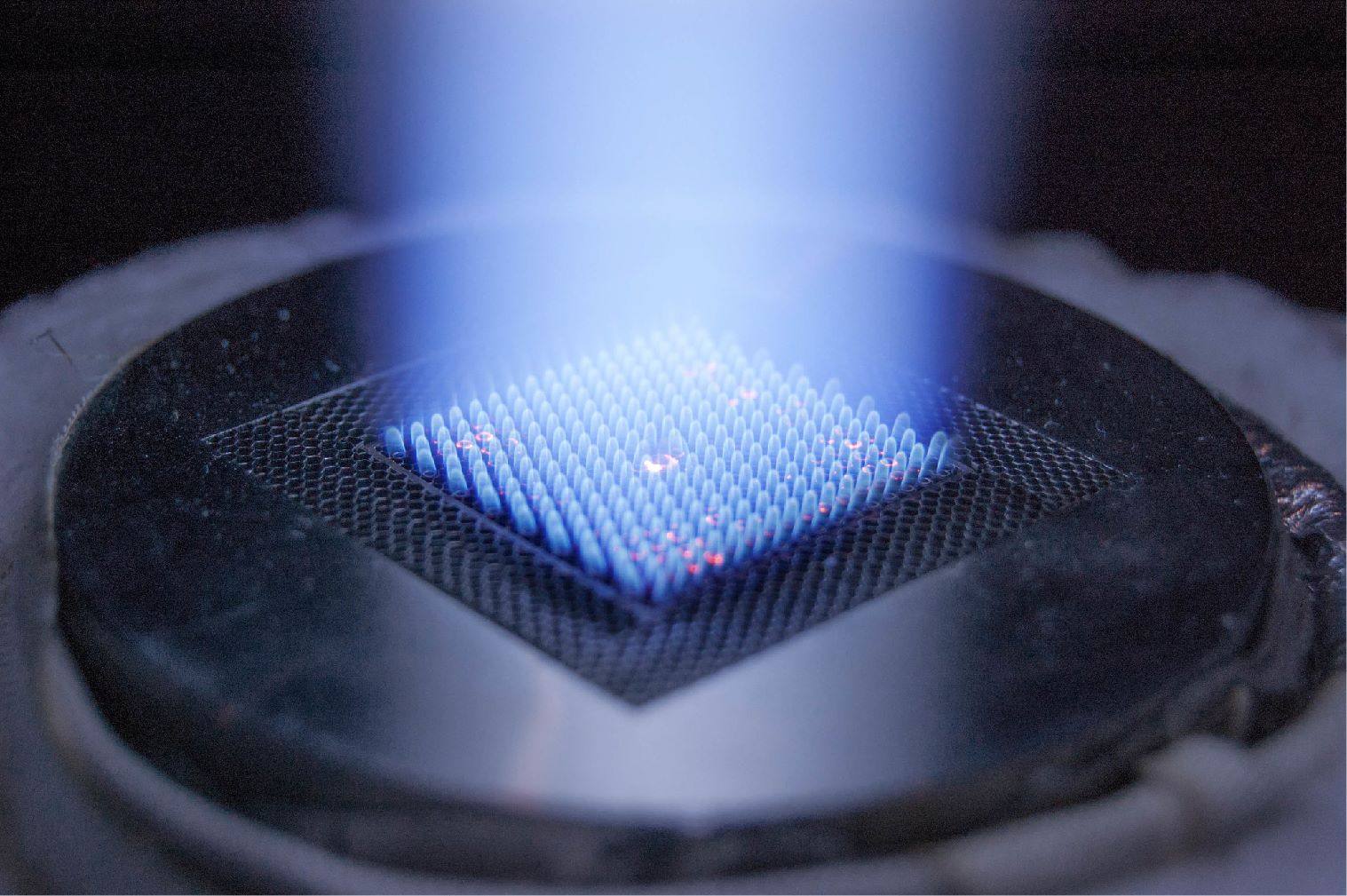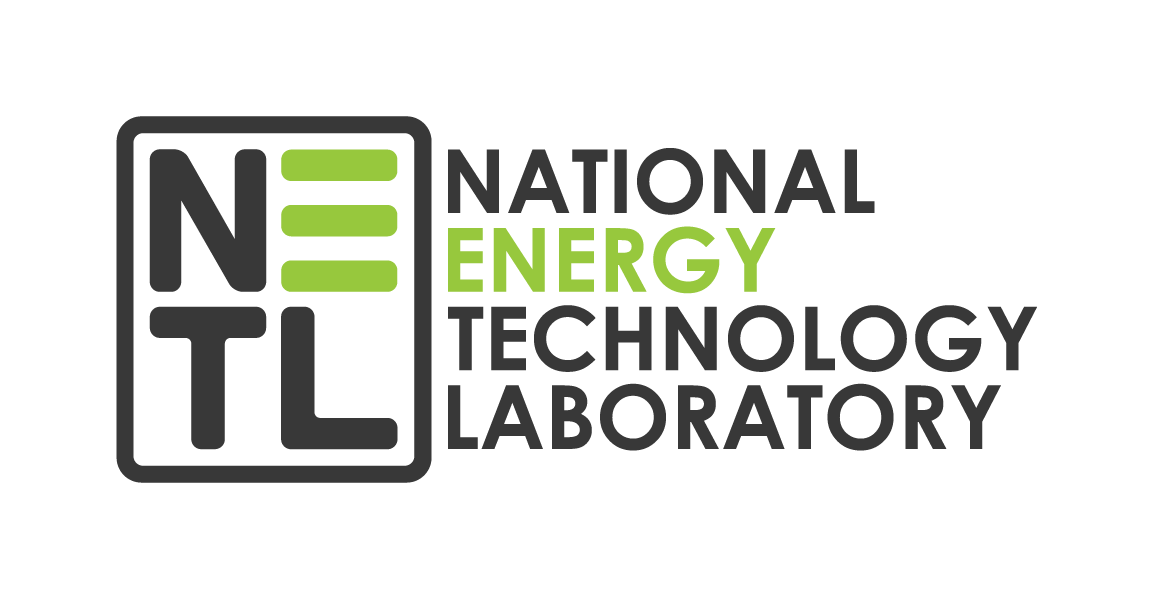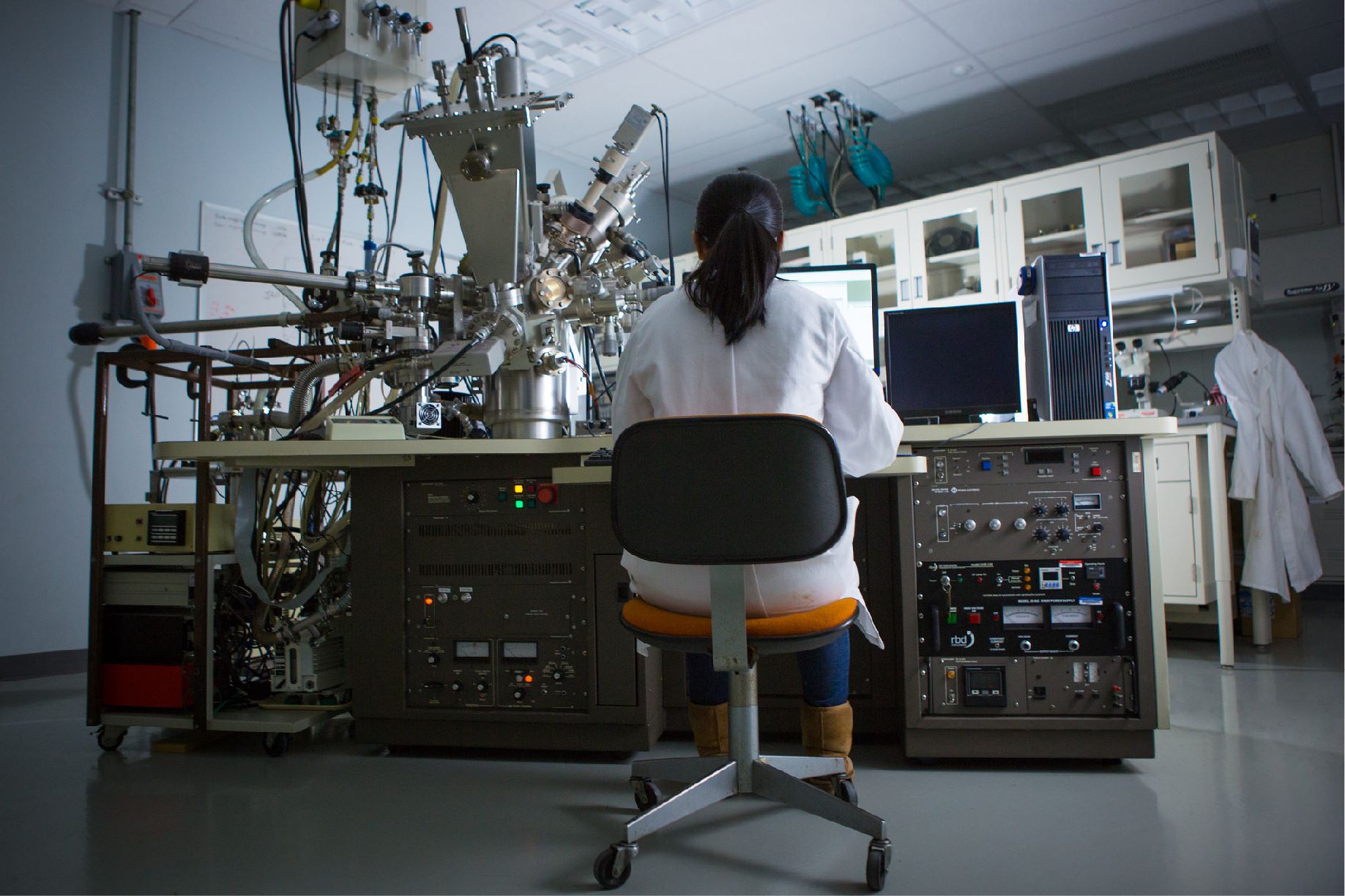Fundamental Understanding of Methane-Carbon Dioxide-Water (CH4-CO2-H2O) Interactions in Shale Nanopores under Reservoir Conditions
Last Reviewed Dated
05/18/2022
Goal
Project personnel will systematically study CH4-CO2-H2O interactions in shale nanopores under high-pressure and -temperature reservoir conditions, with the ultimate goal of developing new stimulation strategies to enable efficient and less environmentally harmful resource recovery from fewer wells.
Performer(s)
Sandia National Laboratories (SNL), Albuquerque, NM 87123
Background
Shale is characterized by the predominant presence of nanometer-scale (1-100 nm) pores. The behavior of fluids in those pores directly controls shale gas storage and release in the shale matrix and, ultimately, the wellbore production in unconventional reservoirs. It has been recognized that a fluid confined in nanopores can behave dramatically differently from the corresponding bulk phase due to nanopore confinement. CO2 and H2O (either preexisting or introduced) are two major components that coexist with shale gas (predominately CH4) during hydrofracturing and gas extraction. Liquid or supercritical CO2 has been suggested as an alternative fluid for subsurface fracturing such that CO2 enhanced gas recovery can also serve as a CO2 sequestration process. Limited data indicate that CO2 may preferentially adsorb in nanopores (particularly those in kerogen) and displace CH4 in shale. Similarly, the presence of moisture seems able to displace or trap CH4 in the shale matrix. Therefore, fundamental understanding of CH4-CO2-H2O behavior and their interactions in shale nanopores is vitally important for gas production and related CO2 sequestration.
Impact
The proposed work will address the following knowledge gaps:
- Most existing gas sorption work has focused exclusively on single component systems. No measurements have been made for a mixture of CH4-CO2-H2O under reservoir conditions. Molecular dynamics simulations of a CO2-CH4 mixture in carbon nanopores indicate complex interactions between the two components.
- Sorption-desorption hysteresis is typically observed of fluids in nanoporous materials. We hypothesize that hysteresis may occur during CH4 sorption-desorption in the shale matrix. If confirmed, this hypothesis will provide us with a completely new perspective for understanding shale gas disposition and release in an unconventional reservoir. Unfortunately, no measurements have been made thus far on the entire cycle of CH4 sorption and desorption in shale samples. The presence of CO2 or H2O is likely to promote hysteresis for CH4 sorption and desorption.
- The fundamental question regarding CH4 disposition and release in shale pores requires an atomistic understanding of the physical and chemical interactions among shale materials, CH4, H2O, and CO2. However, no systematic simulation study has been performed to specifically examine CH4 behavior in nanopores of different materials, sizes, and shapes in the presence of other fluid phases for the purpose of understanding the complexity of natural gas recovery from shale reservoirs.
- The equation of state (EOS) for predicting the thermodynamic behavior of CH4-CO2-H2O in shale is still missing.
Project personnel propose to bridge these gaps by using an integrated experimental and modeling approach to systematically study CH4-CO2-H2O interactions in shale nanopores under high-pressure and -temperature reservoir conditions.
The proposed research will (1) significantly advance fundamental understanding of hydrocarbon storage, release, and flow in shale; (2) provide more accurate predictions of gas-in-place and gas mobility in reservoirs; (3) help to develop new stimulation strategies to enable efficient and less environmentally harmful resource recovery from fewer wells; and (4) provide the basic data set to test the concept of using supercritical CO2 as an alternative fracturing fluid for simultaneous CH4 extraction and CO2 sequestration. The work will leverage unique SNL capabilities: nanogeochemistry, high-pressure and -temperature geochemistry, numerical modeling, nanoscience, and neutron scattering.
Accomplishments (most recent listed first)
Project researchers obtained 10 shale core samples (including samples from Mancos, Woodford, and Marcellus) and model materials. They also obtained one relatively pure kerogen isolate from Mancos shale. Additional kerogen extractions from Woodford shale (immature) and Marcellus shale (mature) were prepared using solvent extraction, acid demineralization, and critical point drying. Low angle neutron scattering analysis was performed on Mancos shale samples. The team designed and constructed a unique high-temperature and -pressure experimental system that can measure both P-V-T-X properties and adsorption kinetics sequentially. Researchers completed the first set high-temperature high-pressure (HTHP) measurement for a gas mixture of 90% CH4 and 10% CO2. More measurements for other mixtures with different CH4 and CO2 concentrations are currently underway. Complementary to the HTHP experiments, researchers have completed a set of high-temperature and low-pressure CH4 adsorption measurements using a thermal gravimetric analyzer. Significant progress has been made on molecular dynamics modeling. The major findings up to date include:
- Neutron scattering analysis shows the pores in Mancos shale are dominated by those with size < 100 nm, consistent with reported data for shale in general. Specific surface area of kerogen from Mancos shale is determined to be ~ 2 m2/g, smaller than expected.
- Both low-pressure and high-pressure sorption measurements indicate significant sorption of CH4 (and CO2) on clay materials. Given the dominant presence of clay materials in shale, the sorption of CH4 on clays may contribute a significant portion of gas in place in a reservoir.
- The sorption measurement on activated carbon (used as an analog to kerogen) indicates that sorption capacity of kerogen could be one order of magnitude higher than that of clay materials.
- The HTHP measurement conducted has demonstrated the applicability of SNL’s hydrothermal system for shale gas study. A thermodynamic model (EOS) for data interpretation was developed for estimating sorption capacity and rate.
- Various kerogen models have been constructed for molecular dynamics (MD) simulations. The MD simulations have calculated the sorption isotherms for CH4 sorption on the model kerogen materials. The relative release rates of adsorbed CH4 molecules on different kerogen sites have also been calculated.
- Completed full cycle of adsorption-desorption measurements.
- Performed high-pressure and high-temperature sorption measurements on crushed shale samples.
- Performed sorption measurements on multicomponent systems to clarify the interactions among different components (CH4-CO2-H2O).
- Complete the calculations on CH4-CO2-H2O sorption and desorption in kerogens. Experimental data interpretation and atomistic modeling was used to understand how molecular structures of kerogen control gas (CH4, CO2, and H2O) sorption and desorption. Related work was presented at the Annual American Geological Society Meeting and the American Chemical Society Meeting.
- Previous research showed that kerogen dried under air has collapsed, damaged pore structure, and does not represent the original state of kerogen in shale. To remedy this situation, critical point drying was accomplished by passing the liquid to a gas state without crossing the phase-boundary. All subsequent analyses will be using these pore-preserved kerogen materials.
- Kerogen extracted from Woodford shale and Marcellus shale have been characterized using Attenuated Total Reflectance Fourier-transform infrared spectroscopy (ATR-FTIR) and Brunauer-Emmett-Teller (BET). CO2 adsorption and desorption isotherms for extracted kerogen were measured at 273 K and 300 K. The specific surface area for kerogen from Woodford shale is 50 cm2/g and 357 cm2/g for Marcellus kerogen, which are consistent with maturity measurement by vitrinite reflectance with Woodford shale being immature and Marcellus shale being mature.
- Marcellus kerogen pore-size distributions, obtained using classic Density functional theory (DFT) model from liquid nitrogen adsorption, shows bimodal distributions with micropore (2 nm or less) accounting for more than 75% of the total pore volume and the rest being 25% pore volume from pores with 20–30 nm diameter. There are no pores between 3 nm and 20 nm (confirmed by scanning electron microscope (SEM) images) from Marcellus shale, which is very unusual for mature shale with maturity of 2.2 (VRo). Kerogen spatial heterogeneity in maturity is being analyzed using FTIR microscope and Raman microscope.
- A new kerogen model has been developed that can provide a better representation of molecular structures of the material as revealed by spectroscopic data. This model is then used to investigate the effect of dewatering and H2O content on the micro-porosity of clay aggregates. The results suggest that slow dewatering will create more compact aggregates compared to fast dewatering. The results also indicate that H2O content affects the porosity of the clay aggregates. In addition, the work indicates that CO2 has a much higher affinity for clay materials than CH4 as compared to matured kerogen.
- The model also indicates that kerogen may swell upon gas sorption, which may affect the porosity and permeability of shale. Experiments indicate that kerogen insignificantly swells under He adsorption. However, kerogen volume increases up to 5.4% and 11% upon CH4 and CO2 adsorption at 192 atm, respectively. The kerogen volume increases when gas pressure increases, and at the same gas pressure it increases more in CO2 than in CH4. It is therefore necessary to include kerogen swelling in the porosity, permeability, and adsorption data interpretation, and provide a mechanistic understanding of the interaction between kerogen and gas.
- The molecular dynamics (MD) simulation results (above) showed that kerogen swelling increased the surface area, porosity and shifted the pore size distribution (PSD) to larger pores. The kerogen swelling is shown to increase with kerogen maturity and pore pressure. A simple experiment was designed to study the swelling induced deformation for two type-II kerogens. The results confirm that kerogen swelling by CO2 will increase the surface area and shift PSDs to larger pores. The swelling process is not reversible after the gas unload, and such “permanent deformation/damage” effect can accumulate after load/unload. The swelling induced deformation is larger for kerogen with higher maturity kerogen.
- SNL has demonstrated that nanopore confinement can lead to unexpected isotopic fractionation of a fluid flow in a shale formation and the resulting isotope signature can be used to trace the flow pathway. This isotopic fractionation was test in a cooperative experiment with Prof. Sharma and her team at West Virginia University compiled a large set of geochemical data for 400 produced waters from USGS, MSEEL, and EDX databases. The data shows that the ultrafiltration-induced oxygen and hydrogen isotopic fractionation may also take place in shale gas/oil production. Such isotopic signatures can potentially be used to understand and even quantify water production in hydrocarbon production in unconventional reservoirs
Current Status
The project is also working on the effects of gas extraction on water-kerogen contact angles. Molecular dynamics (MD) simulations were performed to investigate the wettability alteration of kerogen and mineral upon CH4 extraction and CO2 injection. The results indicate that contact angle of a water droplet changes significantly with a changing gas pressure for kerogen and pyrophyllite surfaces. This means that upon CH4 extraction, the gas pressure decreases and so does the contact angle of water droplet, suggesting that more water can move into the kerogen matrix during the gas extraction process. However, during CO2 injection, the CO2 gas pressure increases upon injection. The surface becomes more hydrophobic, indicating that water would move away from the kerogen surface and make the surface available for CO2 gas adsorption. The results have a significant implication to reservoir-scale simulations for shale gas extraction and CO2 injection.
In May 2021, SNL received $500K in funding to continue work on CH4-CO2-H2O interactions that was being conducted under FWP 19-021410 which expired 9/30/2020. The funding was delayed because it was tied to two other FWPs that needed to be issued concurrently. Due to the time delay in receiving the funding a No Cost Time Extension (NCTE) for the project was granted that extends the project to September 30, 2022.



